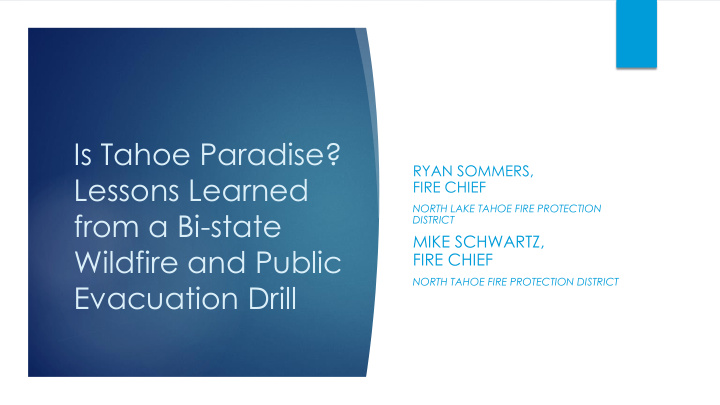



Is Tahoe Paradise? RYAN SOMMERS, Lessons Learned FIRE CHIEF NORTH LAKE TAHOE FIRE PROTECTION from a Bi-state DISTRICT MIKE SCHWARTZ, Wildfire and Public FIRE CHIEF NORTH TAHOE FIRE PROTECTION DISTRICT Evacuation Drill
Is Tahoe Paradise? Photo Courtesy Hillary Guttierez Lessons Learned From A Bi-State Wildfire and Public Evacuation Drill Photo Courtesy Associated Press
Ryan Sommers Chief Ryan Sommers Chief Michael Schwartz North Lake Tahoe Fire Ryan Sommers North Tahoe Fire
Preparation Safe Evacuation Cooperation
P.R .R.I.D .I.D.E. .E. • Tested • Brings responding agencies together working in unison • Safely evacuates residents • Unites the community • Creates Fire Adapted Communities
• Pr Pre-Planning lanning Pr Proced ocedure res: s: • Review local/county evacuation plans • Determine local fire danger rating, major disaster threat; focus evacuation on most threatening risk • Pla lanning ning Your ur Drill: ill: • Establish objectives for neighborhood • Describe and name your scenario education • Determine the area to be evacuated • Determine escape routes, and the number of people to be maintenance, security and signage of evacuated routes, evaluate road closures • Identify the evacuation center • Contact local Reverse 911/Code Red • Plan incidents within incidents Provider • Follow the Incident Command System • Establish a plan for phone trees and for the drill assign neighborhood captains • Hold regional meetings with responding agencies impacted during a disaster
• Implemen lementing ing the P. P.R.I.D.E. Pr Progr ogram am: • Ev Evacuation acuation Cent nter er Reco comm mmenda endations ions: • Begin with specific programs needed • Volunteers needed to register in your community residents and pets Defensible space, etc. • Set up booths for disaster related • • Determine evacuation routes vendors Defensible space experts • Meet with GIS, share maps, patrol for • access • Insurance companies • Attend HOA/Community Advisory • Retrofitting companies Meetings and share concerns and • Animal Service Needs desire to educate • Shelters and microchipping • Advertise classes, notify residents through • Red Cross schools, store fronts, door to door • Local vendors donation of food/water • Organize classes and training to prepare your community • Security at evacuation center and in residential areas • Include Emergency Manager, Animal Services, Law Enforcement, Red Cross • Raffles for adults, activities for kids • Discuss preparedness actions and items to • Information booths for trouble- have ready to go shooting, concerns of residents, areas that need to be addressed
• Debri briefing ing after r the drill: ill: • Cont ntinue inue P.R.I.D. D.E.: .: • Conduct debrief immediately following • Annual education with residents and the drill with all participating agencies participants • Hold debriefing with residents and • Conduct different drills each year community phone tree captains within • Ongoing defensible space inspections one week of drill and follow up • Share: • Billboards promoting helpful tips • Statistics specific to the area • Successes • Seasonal P.R.I.D.E. tips in school Areas for improvement • letters, community newsletters Future needs • • PSAs on local television and radio Future plans •
• Saves lives and property • Fire Adapted Community • Safe, aware and prepared residents • Supportive residents with excellent communication between the fire department and their residents • Confident responding agencies
Stateline Kings Beach/Brockway Springs, CA Incline Village, NV Crystal Bay
Over 17 Agencies 1,531 People Participated
This exercise was the first time in the US that commercial drones conducted simultaneous operations with manned emergency aircraft in the same airspace, during a real time scenario.
Incident within the Incident: Planned 19 Incident within the Incident: Not planned 2
By the Numbers 13,992 residents notified 1,100 asked to evacuate 381 notified door to door 483 residents checked in at the Evacuation Center 89 Animals checked in 38 Animals microchipped
Bi-State Evacuation Drill After Action Lessons learned – What went well • Traffic control/evacuations • Reverse 911 • Number of participants • Communication • Radio usage • Partnership between agencies • Ability of players to adapt
What went well cont. • Coordination and planning prior to the event • Wide variety of systems testing and training occurred • Safety was maintained throughout the event • Sims Table Usage • Presence and influence of Incident Commanders (ICs) • Unified command went smoothly • Using live animals was helpful for animal control
Bi-State Evacuation Drill After Action Lessons learned – What could be Improved • Biltmore area was too noisy and crowded making it difficult to communicate • WEB EOC was not used to its full capability • Reverse 911 wasn’t fully tested (voice was used, not text and e -mail). • The community needs to be educated on the system • Not all who need the notifications get them • Some individuals find the sign-up page difficult to navigate • The website is not ADA compliant • Sometimes when assignments were given, tailgate briefings were not conducted
What could be improved cont. • Lack of community notification about the event despite extensive advertising • Poor access to homes with gates for law enforcement lacking codes • During a fire incident we found discrepancies between the number of dwellings identified by 911 calls versus doors knocked on versus houses at risk • Improvements needed on information sharing between volunteer agencies (CERT, VOAD, FEMA, SA, etc .) and Incident Command regarding # of volunteers on site and hours logged.
ARE YOU READY? ROUTES SAFE ZONES SHELTER
EVACUATE WHEN YOU ARE ASKED TO DO SO
WWW.NTFIRE.NET
NOTIFICATIONS
Incline Village / Crystal Bay-Washoe County Visit NLTFPD.net for more information in the Incline Village area
Questi estions ons
Recommend
More recommend